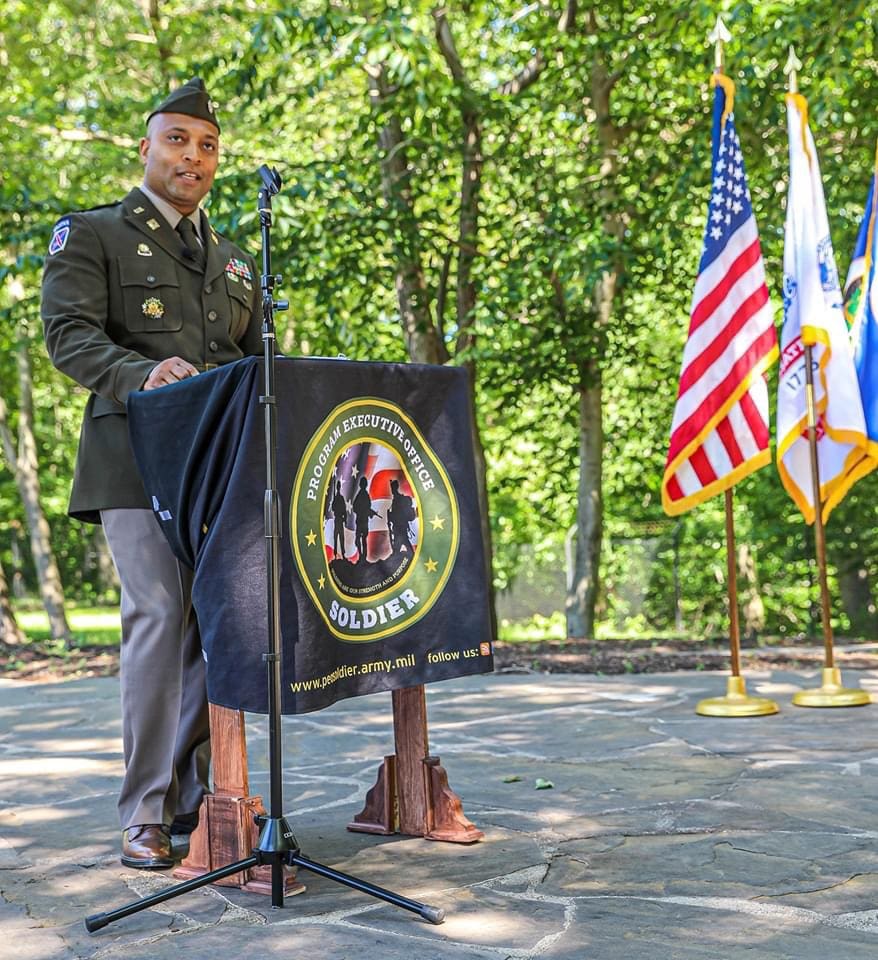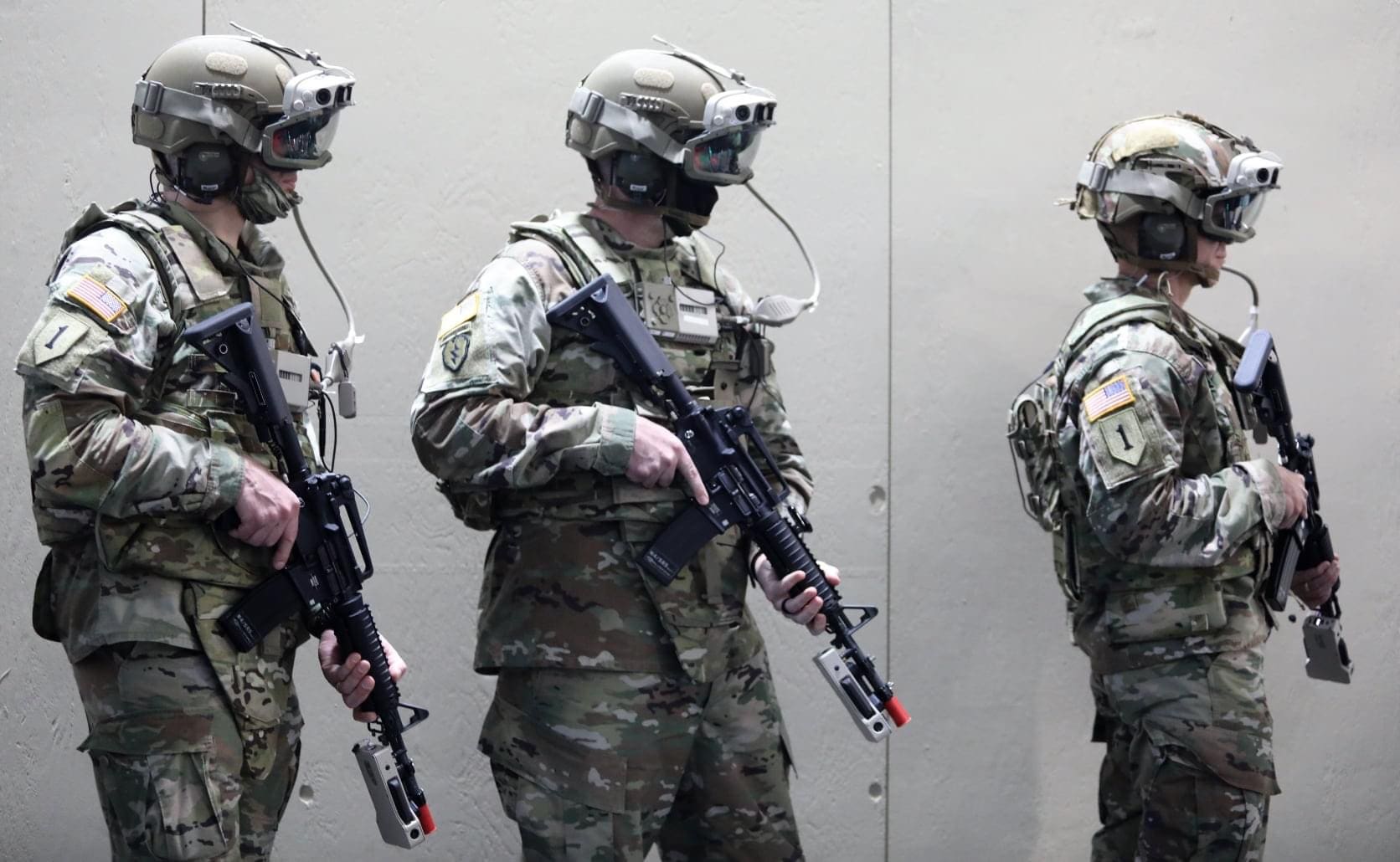
Sergeant Major of the Army Michael Grinston and other senior enlisted leaders run through a synthetic training environment at PEO Soldier’s Soldier Integration Facility (SIF) at Fort Belvoir.

Sergeant Major of the Army Michael Grinston and other senior enlisted leaders run through a synthetic training environment at PEO Soldier’s Soldier Integration Facility (SIF) at Fort Belvoir.
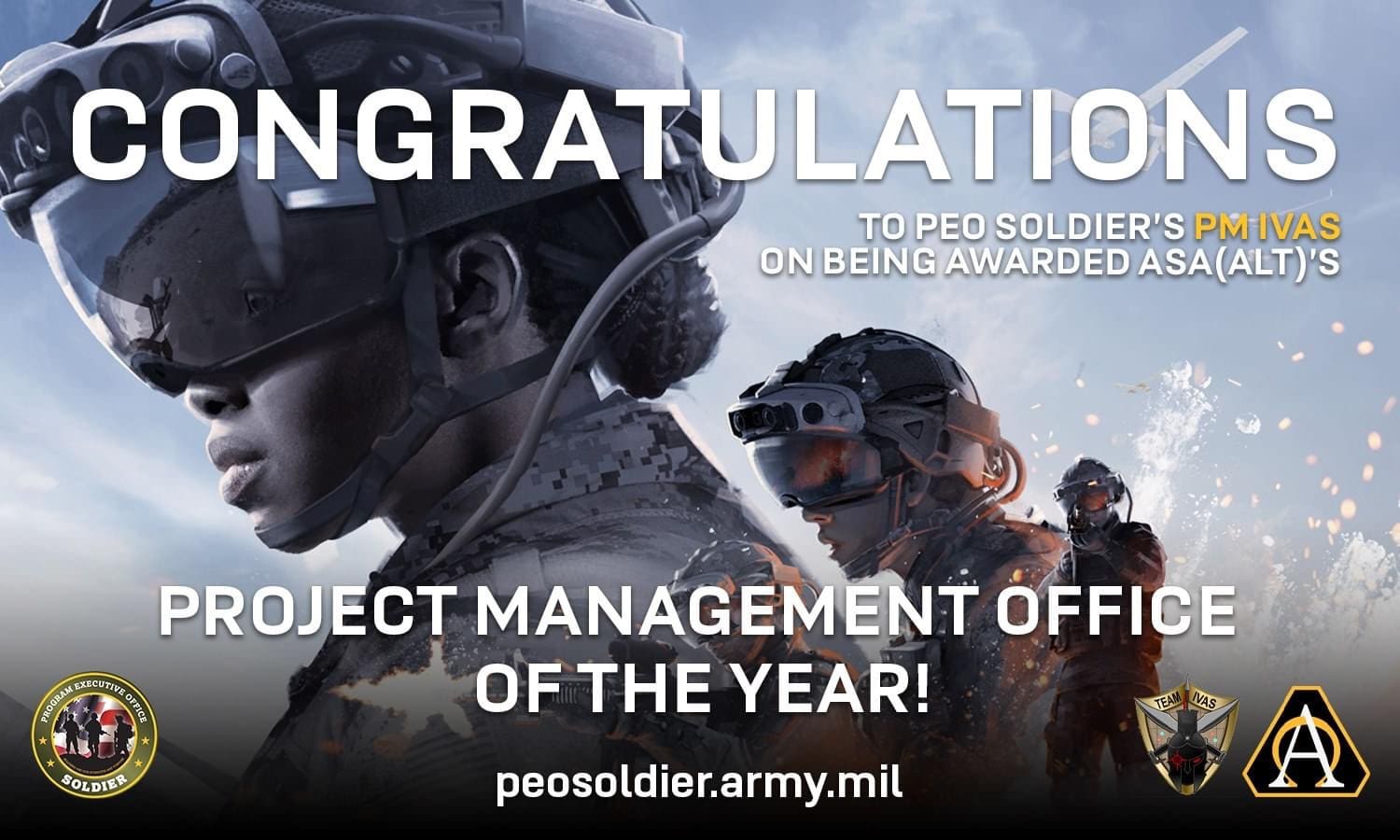
Congratulations to Program Executive Office (PEO) Soldier’s Project Manager Integrated Visual Augmentation System (PM IVAS) for being recognized as Assistant Secretary of the Army – Acquisition, Logistics & Technology’s O6 Project Manager of the Year.
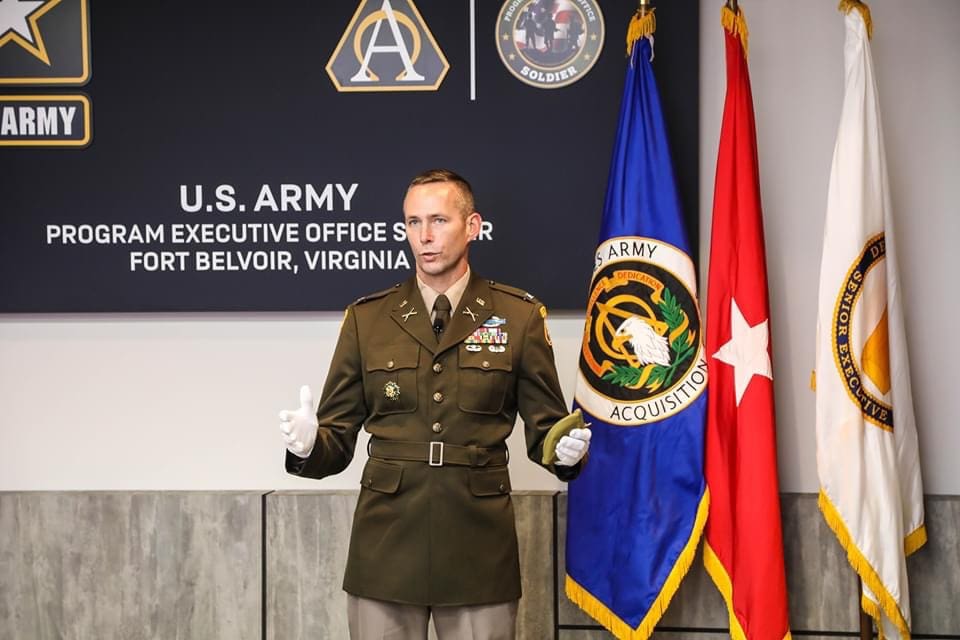
COL Derek Bird assumed responsibility as Project Manager, Soldier Survivability (PM SSV) during a change of charter ceremony last Friday at Fort Belvoir. COL Bird previously served as Product Manager, Ground Soldier Systems (PdM GSS) earlier in his career.
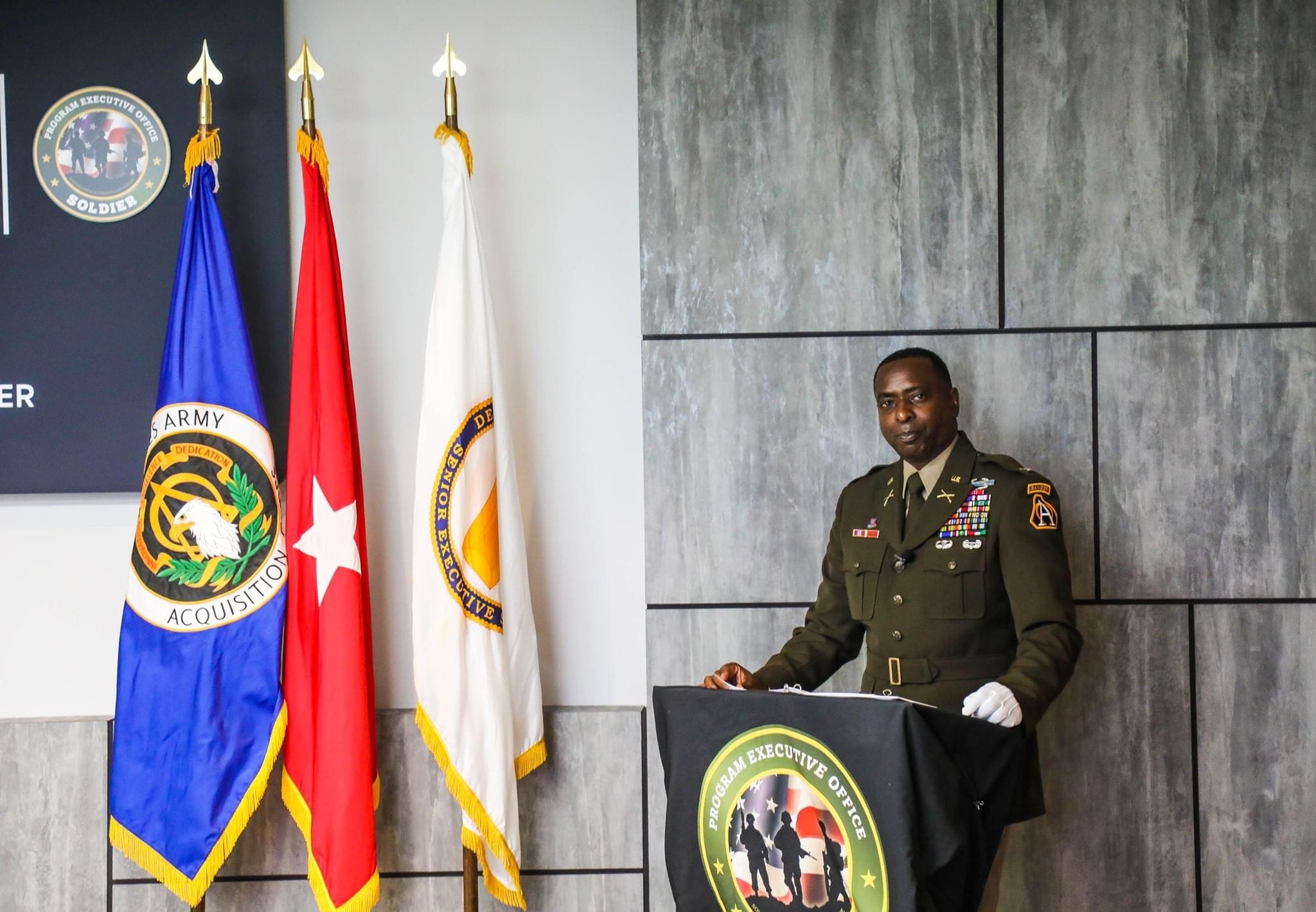
PEO Soldier thanks COL Stephen Thomas for his outstanding leadership and tireless efforts as Project Manager, Soldier Survivability (PM SSV). During his tenure, COL Thomas oversaw the development and fielding of systems, equipment and clothing that improved Soldier protection and enhanced mission capabilities throughout the Army.
Good luck!
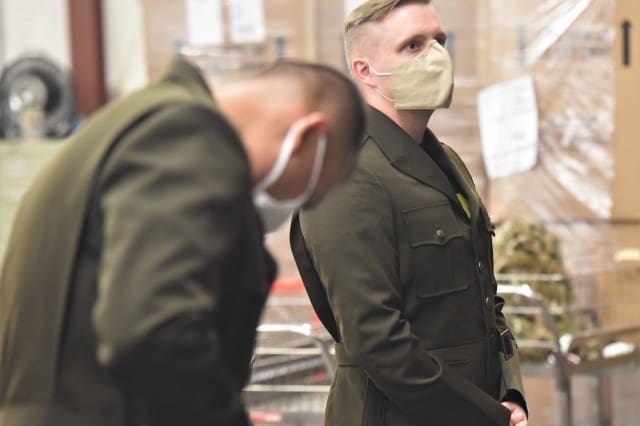
WASHINGTON — Recruiters, drill sergeants, and initial entry trainees will be among the first to receive the new Army Green Service Uniform, as program officials look to distribute it to all installations by the middle of next fiscal year.
The uniform harkens back to the “greatest generation” of Soldiers who fought during World War II.
“For the past year, I’ve been wearing the Army Greens. Wherever I go, people tell me that they love the uniform,” said Army Vice Chief Of Staff Gen. Joseph M. Martin.
“As we transition to the next phase of the rollout, I’m excited for the Soldiers who are about to receive the uniform,” he added. “I think that when they see themselves in the mirror they’ll feel connected to the Soldiers of the past and realize that they’re writing the next chapter of what people feel about our Army.”
Rollout schedule
Personnel in basic combat training and one-station unit training should receive the AGSU beginning in the first quarter of fiscal year 2021, said Lt. Col. Naim Lee, product manager of Soldier Clothing and Individual Equipment at Program Executive Office Soldier.
Fort Sill, Oklahoma, will be the first training location to issue the uniform, shortly followed by Fort Leonard Wood, Missouri; Fort Benning, Georgia; and Fort Jackson, South Carolina, he added.
The Army had originally planned to begin issuing the uniforms at IET locations before the end of this fiscal year. However, Lee said, setbacks during production related to COVID-19 forced a short delay in the rollout process.
Soldiers attending the Army’s Recruiting and Retention College at Fort Knox, Kentucky, started to receive their AGSUs earlier this month, he said.
The Army is continuing to work through its distribution and production channels to ensure all recruiters are issued the uniform starting in November through April 2021.
“The Army prioritized recruiters and drill sergeants, because they serve as the face of the Army,” Lee said.
After a select group of recruiters were able to wear the uniform as part of a pilot, they indicated that the new uniform may help attract quality applicants. The uniform may also help inspire the next generation of leaders by connecting the “all-volunteer force” to its historical lineage, Lee said
Moving forward, the Army and Air Force Exchange Service will supply the new uniform through a wave-based rollout approach, Lee said. The AGSU is currently available for purchase at the Fort Knox AAFES location.
The majority of AAFES locations within the U.S. are scheduled to have the new uniform by December. Stores in Alaska, Europe, Japan, and South Korea, along with National Guard and Reserve military clothing locations, should have a supply of uniforms by February 2021.
The mandatory wear date for all Soldiers is Oct. 1, 2027.
Active-duty enlisted Soldiers, including Active Guard and Reserve Soldiers, will continue to receive their annual clothing-replacement allowance to offset the new uniform’s cost, Lee said. Other Guard and Reserve Soldiers will begin receiving uniforms no later than the fourth quarter of fiscal year 2021.
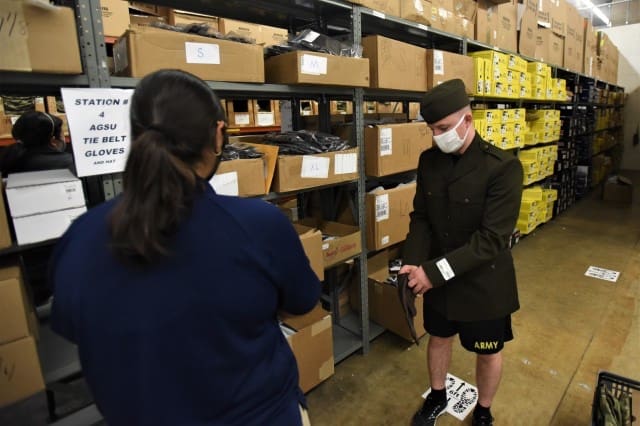
Everyday service uniform
The Army is currently the only service without an everyday business uniform, Lee said.
The current Army Service Uniform, commonly known as dress blues, was previously considered an optional purchase uniform prior to 2008, PEO Soldier officials said. Over time, leaders realized that the dress blues were too formal for everyday business use.
With the launch of the AGSU, Soldiers will now have an everyday service uniform, which will set an appropriate standard for professionalism within an office setting, Lee added.
Eventually, the Army will stop issuing the dress blues to all Soldiers. The uniform will continue to be optional and serve as a dress uniform for all Soldiers requiring a formal attire.
Limited user test, evaluation
As the Army delivers its new uniform, PEO Soldier will continue to conduct limited user testing and evaluations through May 2021, Lee said.
Early in the development process, the Army held an all-female uniform board that determined the design, components, features and fit of the female uniform. While both the male and female uniforms are similar, PEO Soldier officials said the female version allows for an elective skirt and shoe wear option.
In January, leaders held an additional uniform board to solidify minor changes to the uniform that were identified during ongoing user evaluations.
“Soldiers shared how the uniform is a better fit to their body,” when compared to the Army Service Uniform, Lee said. “In terms of comfort — we made changes through the limited user evaluation feedback process” to improve the Army Greens.
Feedback will continue to be solicited from a larger Army population, specifically from Soldiers who wear the uniform often. Through this process, program leads will shape future iterations of the ensemble to accommodate different body types or make improvements to the product’s longevity.
“We have teams that will receive feedback through Soldier touchpoints,” Lee said. “And given the current environment [with COVID-19], we will have to incorporate” other forms of communication.
“Soldiers are enjoying this new uniform and they are eager to go out and get it,” he added. “We can’t get it to them fast enough.”
By Devon Suits, Army News Service
PEO Soldier’s Program Manager Next Generation Squad Weapons has released photos of the latest versions of the three candidate systems for Rifle and Automatic Rifle as well as the two proposed Fire Control Systems.
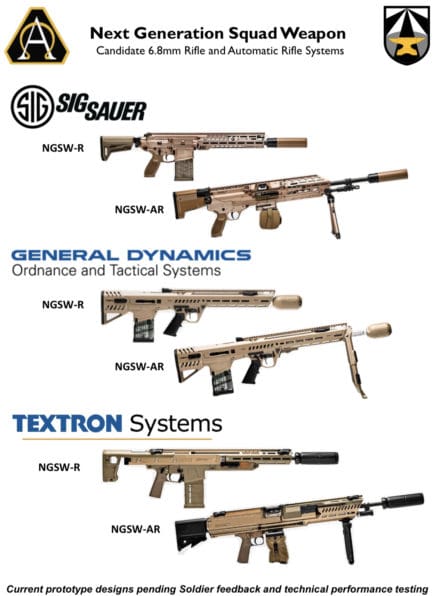
Three industry teams were selected to provide Next Generation Rifle and Automatic Rifle systems to the US Army which will eventually replace the M4 Carbine and M249 Squad Automatic Weapon in the Army’s and potentially other the services’ close combat forces.
These new weapons fire a 6.8mm cartridge unlike anything else in our or other nations’ inventories. It performs in a similar fashion to the commercial 270 Win Short Mag round and will provide our troops with overmatch of threat small arms.
The teams include Textron System, General Dynamics-OTS and SIG SAUER. Each vendor brings a unique perspective to satisfying the Army’s requirement which includes not only weapons but also ammunition which weigh-in at 20% lower than current ammo.
For instance, Textron proposes a Case, Telescoped ammunition and weapons with an entirely new operation system to accommodate their cartridge design. Meanwhile, GD proposes a polymer cased ammo and bullpup weapons. SIG seems to take the low risk approach with weapons most Soldiers will be able to pick up and put right into operation along with a hybrid cased ammo which combines steel and brass in the cartridge case to lighten the load.
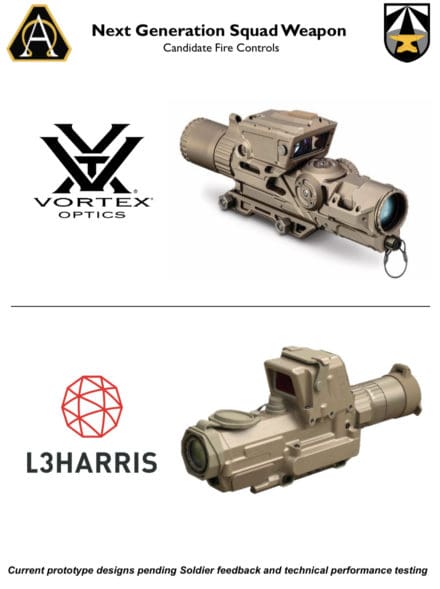
Designed specifically to pair with NSGW’s novel caliber, the two Fire Control System prototypes are provided by Vortex and L3 teamed with Leupold.
Specifically, NGSW-FC is intended to increase the Soldier’s ability to rapidly engage man sized targets out to 600m or greater while maintaining the ability to conduct Close Quarters Battle. This objective is achieved by leveraging technologies to calculate and display a disturbed reticle to the User.
Despite the COVID-19 pandemic, the program office continues to forge ahead on this priority effort with ongoing technical testing at Aberdeen Proving Ground and Soldier Touch Points at Fort Drum, through the end of August. The Army hopes to make a source selection decision by FY 2022.
FORT POLK, La. — Throughout June, C Troop, 3rd Squadron, 89th Cavalry Regiment is conducting in-class and field training with the latest in night-vision goggle (NVG) technology. The new equipment, the enhanced night vision goggles-binoculars (ENVG-B), not only provides an all-around upgrade in clarity, but also comes with thermal vision capabilities, augmented reality with heads-up display and integrates with weapon optics.
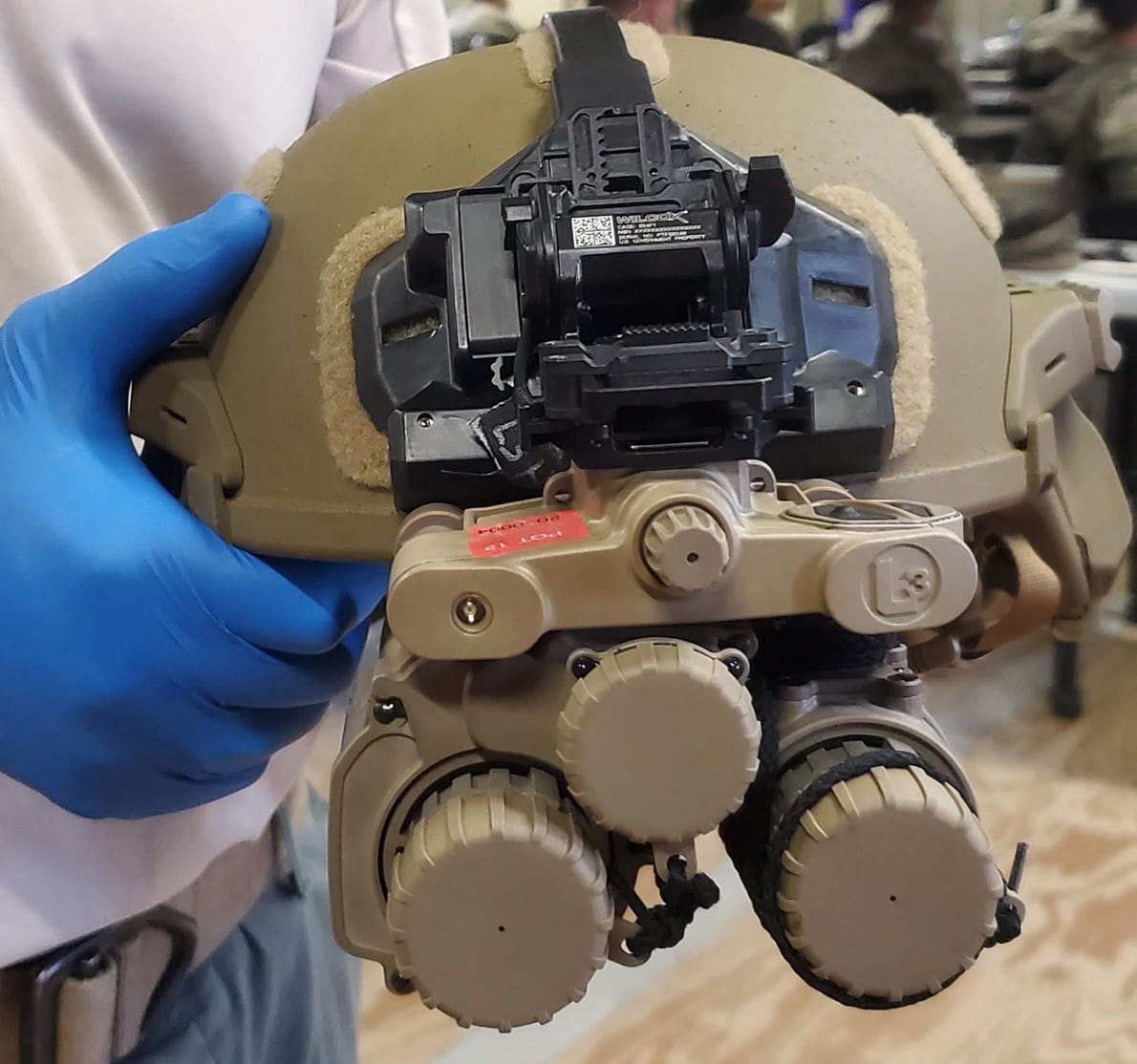
As with all training efforts, the unit is keeping COVID-19 precautions in mind by using the “same social-distancing guidelines that they use at Ranger School and here at the Joint Readiness Training Center. This includes limiting the number of Soldiers and new equipment trainers allowed in the classroom at a given time,” said Capt. William Hess, commander, C Troop 3rd Sqdn, 89th Cav Reg.
During the first week of June, 30 Soldiers received the new equipment training in a classroom environment. Twenty-eight Soldiers, with two on stand-by, completed a range density week beginning June 8, “logging hours with the equipment, executing training according to the Army’s standard qualification tables,” said Hess.
The last two weeks of June are dedicated to situational training exercises. The STX lanes will “use the tactical environment to allow the unit to integrate the newly learned capabilities into our troop leader procedures,” said Hess.
“These Soldiers will be getting a lot of training with the ENVG-Bs.”
Program Executive Office Soldier (PEO Soldier) members from Fort Belvoir, Virginia prompted and supported the ENVG-B training for C troop. Maj. John Nikiforakis, assistant program manager, ENVG-B, PEO Soldier said, “We need to test our night vision technology in a simulated combat environment, so that, by the time it gets to combat, the equipment is refined and ready.”
“As PEO, we are the material developers for technology for the warfighter. Everything we do is geared toward making our Soldiers more lethal, more survivable, and more capable on the battlefield.”
Throughout their training, within and outside of the classroom, Soldiers will gain direct insight into equipment functionality. According to Hess, the Soldiers will also run through the training with the monocular night vision device (PVS-14) — the older NVG model — and then with the ENVG-Bs. Their performance and experiences will be logged, creating a dataset for analysis.
“What we rely on is ‘Soldiers in the loop,’ and that is the Soldier feedback, which ensures the equipment that they are going to fight with is something they actually want to use,” said Nikiforakis.
C Troop Soldiers are excited about the ENVG-B’s and the opportunity to train with the equipment.
Pfc. Hunter Shor, C Troop, 3rd Sqdn, 89th Cav Reg, said, “Compared to the PVS-14s, I just feel the ENVG-B’s are exponentially ahead of their time with thermal technology and integrated systems.”
Similarly, Spc. Simon Ly, C Troop, 3rd Sqdn, 89th Cav Reg said, “It’s been really interesting. I’ve never used equipment with these capabilities before. There are things we can do with the ENVG-Bs that I didn’t think we could do before. For example, the augmented reality that allows us to see checkpoints in the NVGs: I just didn’t know the technology had reached that point.”
With the Soldiers’ feedback and training data, PEO Soldier is able to further ready the device for combat, exceed expectations and meet the needs of Soldiers on the battlefield.
“We go beyond ‘own the night’. We want to be able to identify all threats, under all conditions and be able to shoot first,” said Nikiforakis.
By Christy Graham
Here one of the latest photos of the US Army’s Integrated Visual Augmentation System, a which fuses image intensification and thermal imaging with Augmented Reality overlays. It’s built by Microsoft.
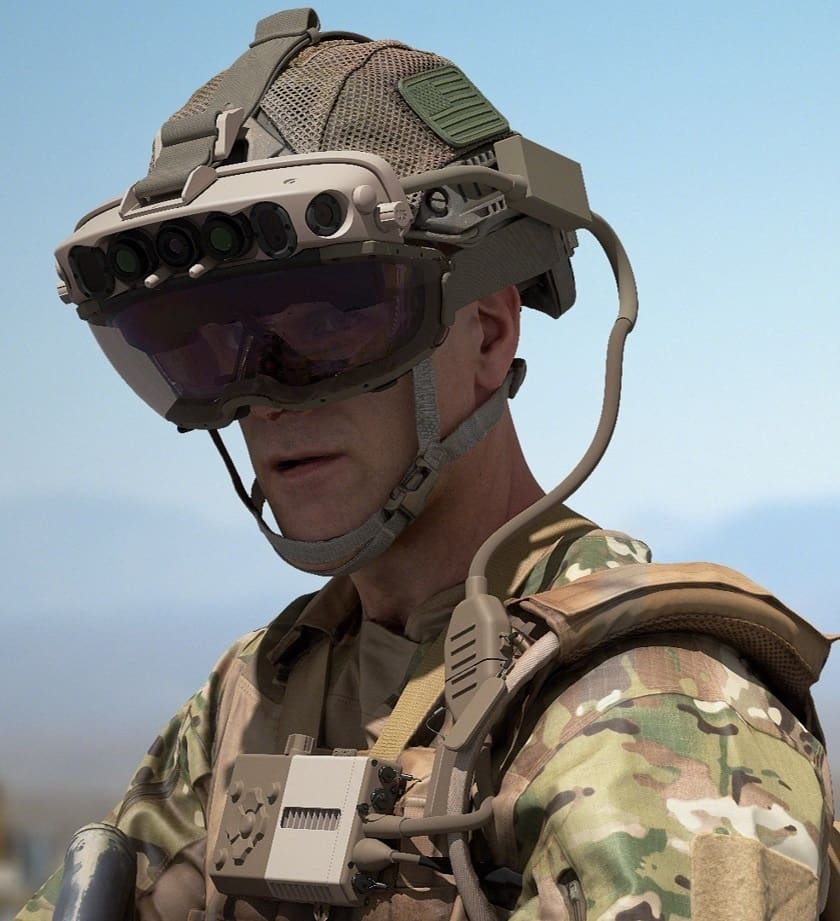
Interestingly, the form factor is pretty similar to the Soldier Integrated Protective Ensemble headborne subsystem from the early 90s.
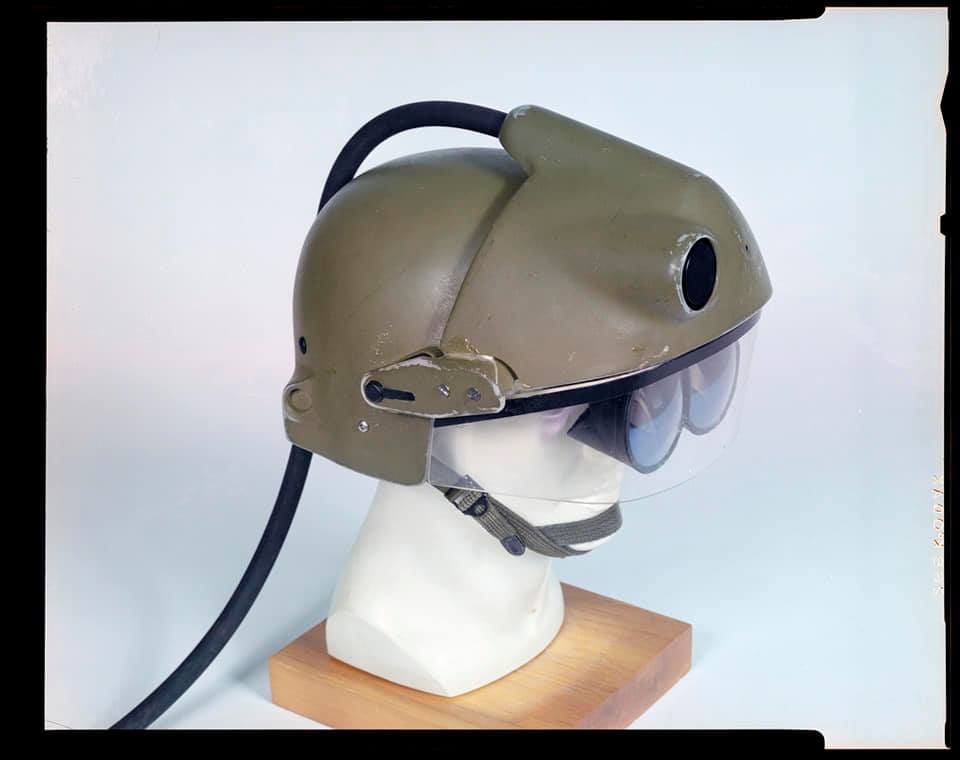
Here’s an update from the Program Office.
FORT BELVOIR, Va.– Cutting-edge modernization efforts come with their own set of challenges, and COVID-19 has ensured that there are no exceptions.
Program Executive Office (PEO) Soldier’s Project Manager Integrated Visual Augmentation System (PM IVAS) continues to leverage the team’s unique structure, talents, and culture to contribute to the force’s readiness, even with the additional challenges presented by COVID-19.
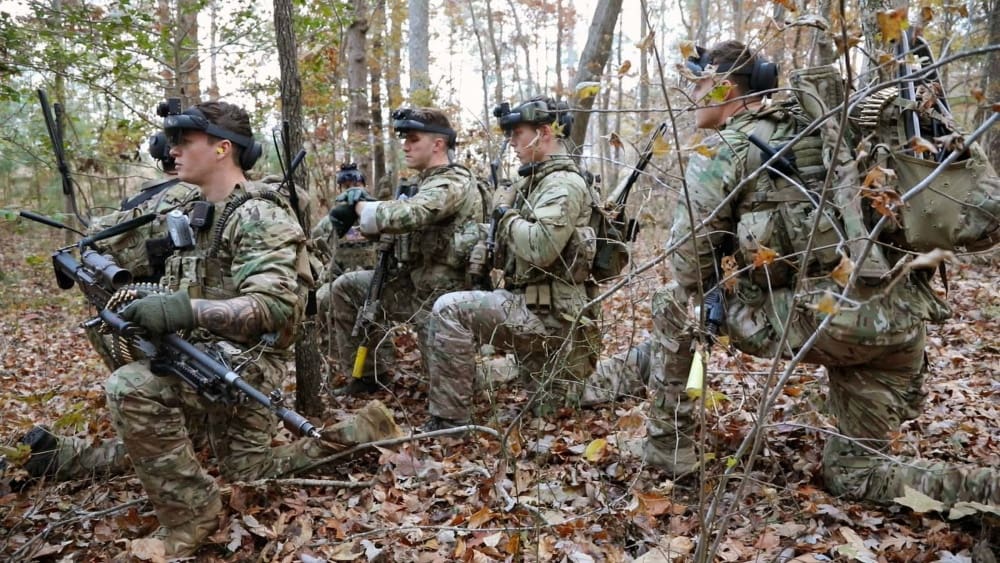
Mark Stephens, PM IVAS Director of Acquisition and Operations, and Jared Walega, PM IVAS Test Director, highlighted how problem solving, routine distributed work solutions, modular architecture design, Soldier Centered Design (SCD), and Supply Chain Risk Management (SCRM) have allowed the project flexibility during the COVID pandemic.
Stephens emphasized how Team IVAS has applied efficient problem-solving skills from the project’s inception.
“Senior defense officials recognized the erosion in close combat capabilities and saw an immediate need to ensure overmatch for our dismounted force,” said Stephens. “Congress recognized the requirement and reprogrammed funds to start IVAS in FY19. Within six months from the Secretary of Defense’s approval in late May, Team IVAS awarded multiple Other Transaction Agreements to industry and kicked off IVAS before Christmas 2018.”
Team IVAS has rapidly solved problems ever since. This includes the successful integration of partners from around the country. Because the team overcame this initial obstacle, remote work is now routine.
The distributed team has built and relied on a digital infrastructure to manage the mission from any physical location. Therefore, they are able to maintain the mission even with the obstacles COVID has presented.
“When COVID hit we had already established a solid Integrated Product Team [IPT] Battle Rhythm using long distance collaboration methods like SharePoint, TEAMs, and Power BI,” Stephens said. “Using TEAMs over the past 18 months allowed video teleconferencing, sharing document collaboration, and reviewing our program management dashboards, so all our leaders were battle tested”.
Secure remote tools have allowed for continued IVAS prototyping through Army Enabled Tests (AET) even while team members are quarantined at home.
“We also implemented a practice of what we call Army Enabled Testing that allows us to get updates from our partners, test the updates in a safe environment, and provide feedback. This methodology helps us manage our performance risks, and not have to wait until Soldier Touchpoint 3 [STP 3] to discover problems,” said Stephens.
Team IVAS’ dynamic problem solving and reliable remote infrastructure guaranteed that aspects of testing continued to ensure minimal overall impacts to the program’s timeline.
“As COVID-19 impacted the organization, the Test Directorate determined we could still conduct a thorough AET with focus on Rapid Target Acquisition (RTA), Tactical Assault Kit (TAK), Synthetic Training Environment (STE), and other necessary capabilities while maintaining requisite social distance and implementing COVID-approved decontamination procedures for the Heads Up Displays (HUD),” said Walega.
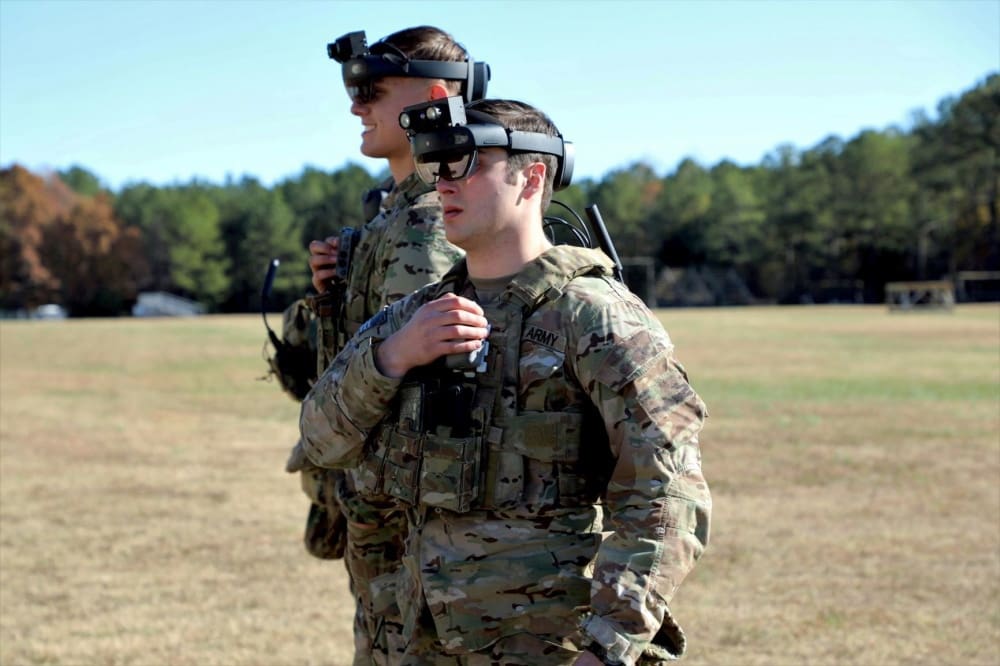
“We have a dispersed team that is capable of downloading the latest software build and loading it onto their HUDs. This process has enabled remote testing of software builds and the ability to provide rapid feedback to Microsoft to include live fire video, data, and assessments,” Walega added.
The continued AET testing and iteration of specific IVAS capabilities through the COVID pandemic has been largely based on the Soldier feedback collected at every stage in development over the last 18 months.
“Soldier Centered Design (SCD) was developed in IVAS as a combination of Human Centered Design and tailored acquisition best practices,” said Walega. “SCD focuses on current Soldier and Marine input throughout the entire development process to prevent engineers and developers from building a product that does not meet the priorities of our warfighters.”
The process puts emphasis on making a product that Soldiers will enjoy using to increase their lethality in training and on the battlefield.
According to Walega, “If a Soldier loves and uses IVAS, then we have provided a system that has much greater capability than the current kit.”
In order to ensure that IVAS will truly maximize Soldier lethality, intentional Soldier feedback at every design and decision point has been a program priority.
“We have collected over 23,000 hours of Soldier feedback,” said COL. Christopher Schneider, Program Manager IVAS. “Because we’ve got so much feedback, we’re highly confident in the current design and STP 3.”
The Soldier-centric approach has turned out to be a key asset to the program during the change in normal operations. Though large scale events such as the IVAS STP 3 will shift due to COVID restrictions, the team has reorganized the internal program schedule so that IVAS is not delayed in deploying to the warfighter.
The team is reordering the intensive hardware and software design reviews that were initially planned for after STP 3, and is leveraging their ingenuity, remote tool infrastructure, and plethora of Soldier feedback to expedite the hardware design review to before the October event. This will allow the formal software design sprint to be completed after STP 3, and both designs to be finalized during Capability Set 4 iterations.
“We wouldn’t have the flexibility that we do, frankly, if we hadn’t been doing Soldier Touchpoints, user juries, user studies, and human factors engineering excursions throughout the last 18 months of the program,” said Schneider.
Though the pandemic has impacted every aspect of the program, including supply chain logistics, industry partners have continued to support with solutions.
“With the advent of the Coronavirus, the supply chain risk management strategy has taken on a new level of importance,” said Nicholas Pate, PM IVAS Manufacturing Engineer.
“IVAS vendors have worked tirelessly to assess, analyze, and make quick decisions to avert imminent delays. Luckily, the PM IVAS supply chain strategy, from the very start of the program, has always been to mitigate risk by avoiding sole sources of supply, cultivating multiple sensor vendors, and ensuring parallel paths of supply,” said Pate.
To date, IVAS vendors have been able to react quickly to minimize negative impacts from the Coronavirus.
“Microsoft, as well as the low light and thermal sensor vendors, delivered preliminary supply chain information on critical components for early risk mitigation assessment on the IVAS supply chain,” Pate added. “This information ensures that quality and security controls are implemented to ensure a stable and sustainable supply chain.”
As Team IVAS continues to overcome COVID’s obstacles, leadership is unwavering in its dedication to the safety of both Soldiers and the team.
“We really took a deliberate thought process and approach to moving the Soldier Touchpoint into October,” said Schneider. “We wanted to make sure that we had the opportunity to get it right.”
Overall, every decision has been made with the safety of the team and readiness of Soldiers as top priorities. Though STP 3 is now taking place in October at Fort Pickett, Va., the rest of the program deliverables remain on track.
“I can absolutely say that today we are on track to meet a fourth quarter ‘21 delivery for our first unit equipped,” said Schneider.
Story by Courtney Bacon.
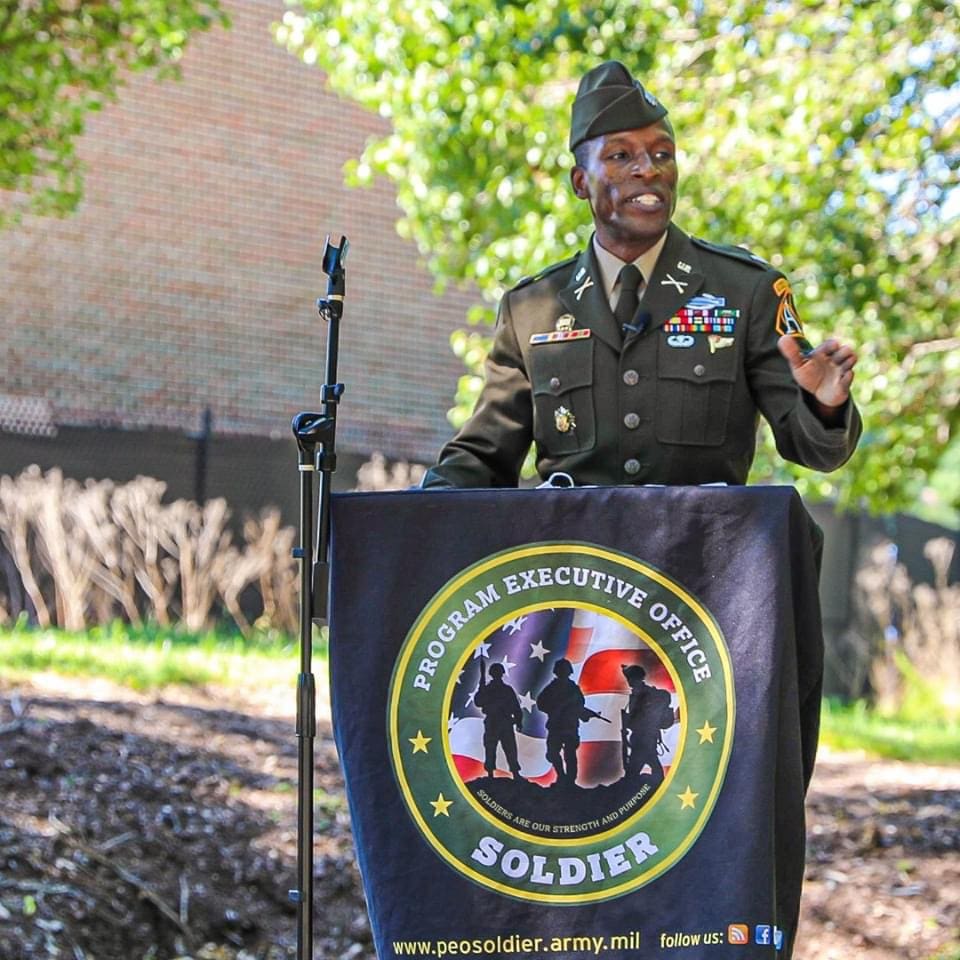
PEO Soldier welcomes to the team Lt. Col. Naim Lee, who was chartered last Friday as Product Manager, Soldier Clothing and Individual Equipment during a change of charter ceremony at Fort Belvoir.
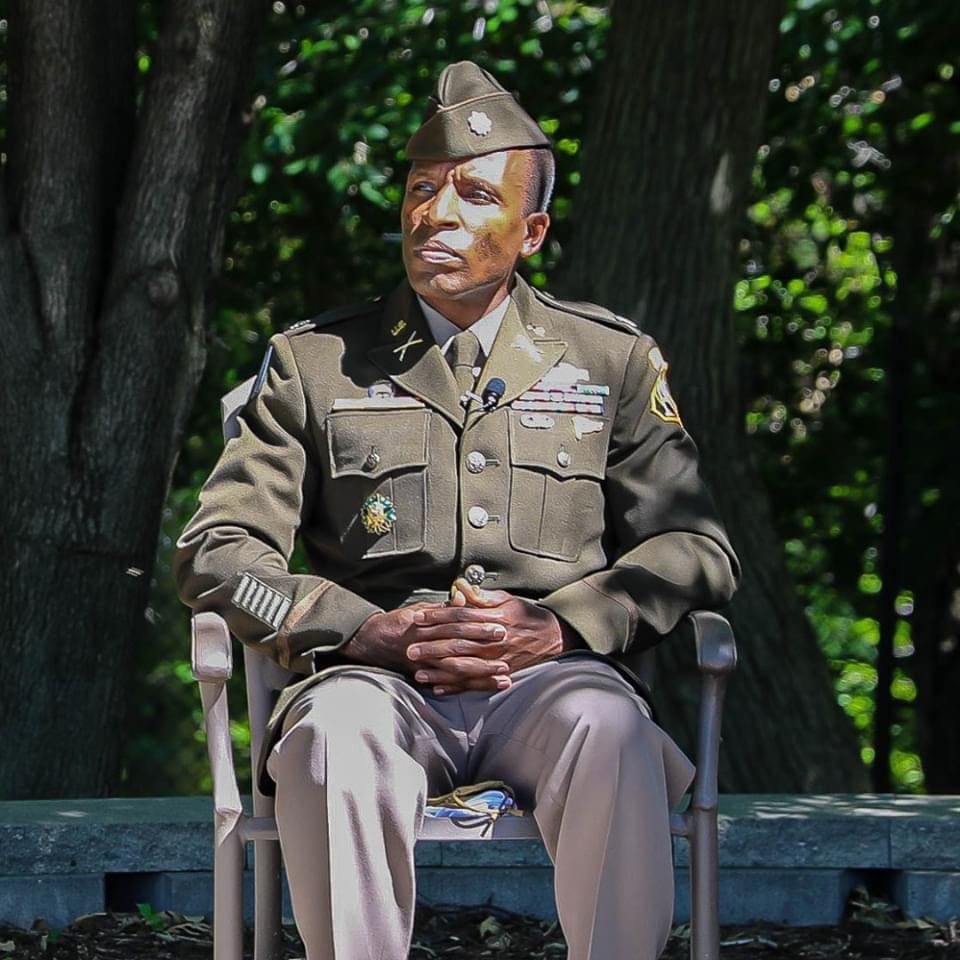
PEO Soldier also thanks Lt. Col. Jonathan Allen for his outstanding performance and leadership in this position. During his tenure, Lt Col. Allen superbly managed the cost, schedule and performance for over 350 acquisition programs resulting in the modernization of clothing, individual equipment and specialized airdrop products for the Army’s current and future force.
